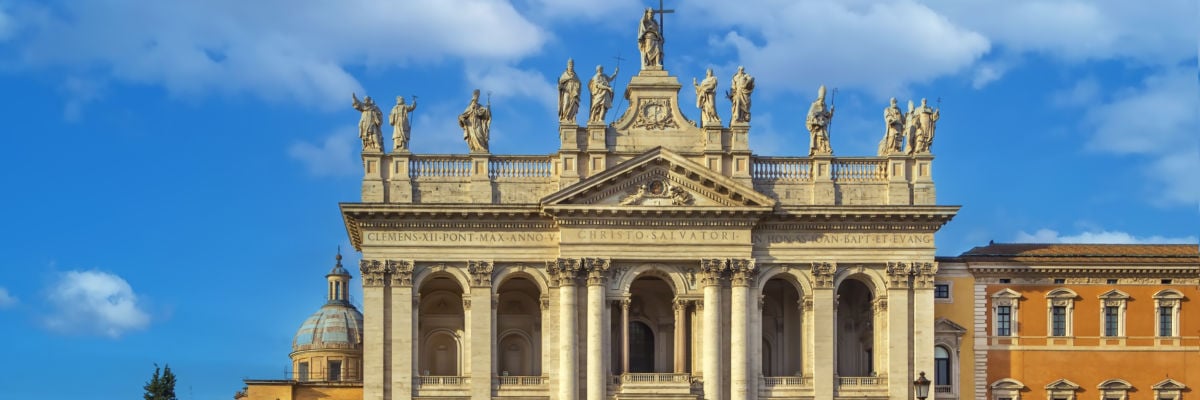
Today’s feast is rare in that it falls on Sunday only once or twice a decade. But even on other days, it is unusual.
In every church, it is normal to observe the anniversary of the dedication, much in the way that we might observe our own birthday, date of baptism, or wedding anniversary. The four major Roman basilicas have, at least in recent centuries, had their anniversaries observed by the whole Latin Church—that is, St. Mary Major, St. Peter, St. Paul, and St. John Lateran. But most of these are optional memorials, whereas today’s feast not only is obligatory, but outranks a Sunday in Ordinary Time.
Though those writing calendar rubrics rarely leave a complete set of explanatory notes about their decisions, we can suggest two primary reasons for this unusual pre-eminence of a particular church building. First, the proper title of the Lateran Basilica is in fact the Archbasilica of the Most Holy Savior and Saints John the Baptist and John the Evangelist at the Lateran. Quite a mouthful, that—no wonder we shorten the name. But the point is that whereas dedications to both St. Johns were added in the ninth century, the original dedication was to Christ the Redeemer, and so this effect makes the day a feast of Our Lord under that title. Second, the Lateran Basilica has long been considered the “mother” of all the churches of the world. Yes, even more so than St. Peter’s. So we honor this particular building, as Pope Benedict declared at an Angelus address in 2008, as “an expression of love and veneration for the Roman Church, ‘which,’ as St. Ignatius of Antioch affirms, ‘presides in charity’ over the entire Catholic communion.”
What a beautiful gesture for us—especially those of us who have chosen, from much prayer and wrestling, union with the Holy Roman and Apostolic See.
Perhaps we should say something about this particular basilica and why it is so significant. It is probably the oldest building made specifically for public Christian worship in Rome. It was dedicated on this day in the year 324 by Pope Sylvester I. Its construction was thanks to not the pope, but the emperor Constantine, who, when he entered Rome in triumph in 312, wanted to offer some sign and gift to the God of Jesus Christ.
This is not the place to judge the extent of Constantine’s personal faith. Whatever his theology at that point, it seems his conviction that it was this God who gave him victory was firm enough that he refused, on entering the city, to offer the customary sacrifices to the gods. Supposedly the Roman establishment was so scandalized by this sleight that Constantine hid from public view for a while.
The site he chose for a new temple was not in the midst of the city alongside the temples of Jupiter or Vesta or Mars, but to the southeast, just inside the walls, next to the Celian Hill on the site of an old barracks and adjacent to a palace that was part of the dowry of Constantine’s wife, Fausta. Yet a traditional Roman temple was a place for the deity, not for the people, hence unsuited for Christian worship, in which the new sacrifice offered was integrally related to the people offering it and the form of offering. So when the Church of the Most Holy Redeemer was built, Constantine used as a model the Roman basilica, a multipurpose rectangular building designed to hold large numbers of people.
The Lateran Basilica, as it came to be called, was the first such building made as a church. But whereas Roman basilicas were modest structures, this church was built on a grand scale, with opulence and beauty, designed to hold 3,000 people. Though Constantine was careful in not thrusting this too much into the face of the Roman establishment, the symbolism was clear enough: this was a symbol of the triumph of Christianity.
The Lateran Basilica from that point became the seat of the bishops of Rome, the popes. And the palace attached to it came to be their official residence all the way up to the Avignon papacy in 1309. The original basilica was destroyed by earthquake in the ninth century and rebuilt; it was destroyed again by fire in the fourteenth century and rebuilt. Later in that same century, it was destroyed by another fire and rebuilt.
Although the popes haven’t lived in the palace since the fourteenth century, the church remains the seat and throne of the bishop of Rome. When Pope Leo took possession of the church and celebrated Mass there for the first time this past spring, he was formally taking up the most tangible aspect of his ministry: the pope leads the universal Church because he leads a particular church with a particular relationship to the universal Church.
There is a concrete, material aspect to the Church that we disregard at our peril. There was something of a modern trend, a moment in history that I think is blessedly now fading away, suggesting that, because ultimately the Church is the people, not a building, the buildings are merely functional and can just as well look like a supermarket or a sports arena as a place of solemnity. This was taking a certain truth and using it as a weapon against other corollary truths. As a comparison, we might remember that the Christian tradition has always insisted on the priority of spiritual things. The state of a person’s soul is ultimately more significant than the state of his body. But this does not mean we can do whatever we want with our bodies, that they are of no significance at all, or that material things are of no significance. We often seem to live, in the twenty-first century, in a constant swinging pendulum between the gnostic extremes of materialism and spiritualism. The fact that many people in this world act as if temporal, bodily things are the only things that matter does not permit us to discard them for some supposedly pure realm of spirit.
“You are God’s building,” St. Paul writes in 1 Corinthians 3. “You are the temple of God.” And so the basilica, in the imagination of the early Roman Church, became a kind of temple of temples, a holy of holies. Rather than something in competition with the ecclesia as people, they saw it as proof and a sign of that reality. How we house Christ’s body tells an important story to the world, and to ourselves, about what we value and how we treat God’s gifts.
The Church’s greatest “treasures” were, and are, God’s people, as St. Lawrence famously told the pagan authorities of Rome less than a century before the construction of the Lateran basilica. All the more reason to consecrate for them a place worthy of that high calling. Again we can see this in Constantine’s architectural decisions in the fourth century. As far back as we can find them, the rites of the dedication of a church building echo the initiatory rites of the faithful themselves: the building is instructed in the faith through a symbolic writing on the ground; it is purified with salt and washed with holy water; it is anointed with holy oil; upon the altar, which is its heart, incense is burned in the fire of charity; and there, at last, it becomes a place of sacrifice, like the human body and soul, where God’s own creation is returned to him in love and where the fire of God’s own love comes down to us to give life and power.
The story of Christ’s cleansing of the temple in John gives an interesting window into the early Church’s understanding of this dynamic. The old Temple was, they knew, soon to become almost irrelevant in view of the temple that was Christ’s own body. Even so, his disciples could look back and recall the words of Scripture: “Zeal for your house will consume me.” If the Temple was of no consequence in comparison with the true temple to come, why was the Lord so consumed with zeal for it?
The simple answer is that zeal for the Lord’s ultimate abode in heaven must take concrete form on earth, even while we know that here we have, in the words of Hebrews, “no lasting city” (13:14), but seek “a city which is to come.” The movement, emphasized over and over again in the great tradition, from visible things to invisible things, rarely means that we must discard the visible things.
The sacraments are the first and most obvious proof of this. We are asked to look beyond the visible form of bread and wine to the truth of the substantial body and blood hidden within, but this vision of faith does not destroy our sight. Our senses are elevated, educated, vivified, clarified. But they remain, because the Lord died not for us to become some sort of gnostic pure spirit, but to become human beings fully alive, body and soul, shining with the glory of God. The streams of grace flowing out from the holy temple, like in Ezekiel’s vision, bring new life to all creation. The many tangible and visible things that the tradition gives us, from the historical church of St. John Lateran to this and every parish church, are not merely doorways to some secret spiritual realm; they are engines of our sanctification, vehicles that invite us to peer through the mystical veil not just once, as some paltry symbol that can be discarded, its meaning spent, but over and over again as we move further into the beauty of God.
We are on our way home to heaven. To go there, we must first learn to love the home he gives us here, even while we look through and beyond it to the world to come.



